Laura Dietz
UNH at CheckThat! 2025: Fine-tuning Vs Prompting in Claim Extraction
Sep 08, 2025Abstract:We participate in CheckThat! Task 2 English and explore various methods of prompting and in-context learning, including few-shot prompting and fine-tuning with different LLM families, with the goal of extracting check-worthy claims from social media passages. Our best METEOR score is achieved by fine-tuning a FLAN-T5 model. However, we observe that higher-quality claims can sometimes be extracted using other methods, even when their METEOR scores are lower.
LLM-Evaluation Tropes: Perspectives on the Validity of LLM-Evaluations
Apr 27, 2025Abstract:Large Language Models (LLMs) are increasingly used to evaluate information retrieval (IR) systems, generating relevance judgments traditionally made by human assessors. Recent empirical studies suggest that LLM-based evaluations often align with human judgments, leading some to suggest that human judges may no longer be necessary, while others highlight concerns about judgment reliability, validity, and long-term impact. As IR systems begin incorporating LLM-generated signals, evaluation outcomes risk becoming self-reinforcing, potentially leading to misleading conclusions. This paper examines scenarios where LLM-evaluators may falsely indicate success, particularly when LLM-based judgments influence both system development and evaluation. We highlight key risks, including bias reinforcement, reproducibility challenges, and inconsistencies in assessment methodologies. To address these concerns, we propose tests to quantify adverse effects, guardrails, and a collaborative framework for constructing reusable test collections that integrate LLM judgments responsibly. By providing perspectives from academia and industry, this work aims to establish best practices for the principled use of LLMs in IR evaluation.
LLM-based relevance assessment still can't replace human relevance assessment
Dec 22, 2024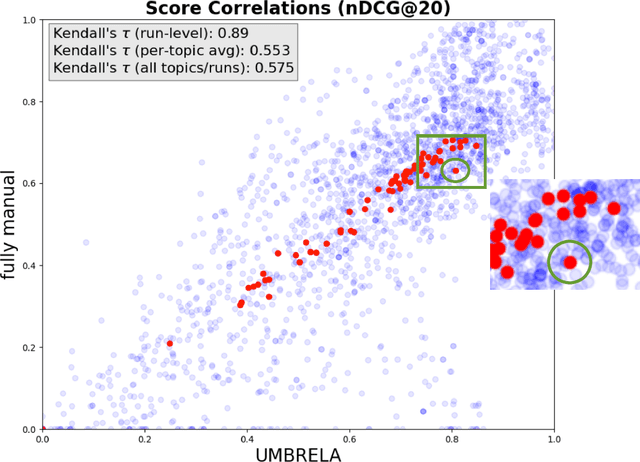
Abstract:The use of large language models (LLMs) for relevance assessment in information retrieval has gained significant attention, with recent studies suggesting that LLM-based judgments provide comparable evaluations to human judgments. Notably, based on TREC 2024 data, Upadhyay et al. make a bold claim that LLM-based relevance assessments, such as those generated by the UMBRELA system, can fully replace traditional human relevance assessments in TREC-style evaluations. This paper critically examines this claim, highlighting practical and theoretical limitations that undermine the validity of this conclusion. First, we question whether the evidence provided by Upadhyay et al. really supports their claim, particularly if a test collection is used asa benchmark for future improvements. Second, through a submission deliberately intended to do so, we demonstrate the ease with which automatic evaluation metrics can be subverted, showing that systems designed to exploit these evaluations can achieve artificially high scores. Theoretical challenges -- such as the inherent narcissism of LLMs, the risk of overfitting to LLM-based metrics, and the potential degradation of future LLM performance -- must be addressed before LLM-based relevance assessments can be considered a viable replacement for human judgments.
Best in Tau@LLMJudge: Criteria-Based Relevance Evaluation with Llama3
Oct 17, 2024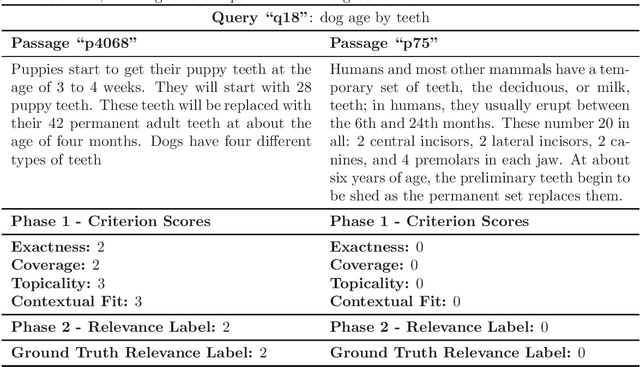



Abstract:Traditional evaluation of information retrieval (IR) systems relies on human-annotated relevance labels, which can be both biased and costly at scale. In this context, large language models (LLMs) offer an alternative by allowing us to directly prompt them to assign relevance labels for passages associated with each query. In this study, we explore alternative methods to directly prompt LLMs for assigned relevance labels, by exploring two hypotheses: Hypothesis 1 assumes that it is helpful to break down "relevance" into specific criteria - exactness, coverage, topicality, and contextual fit. We explore different approaches that prompt large language models (LLMs) to obtain criteria-level grades for all passages, and we consider various ways to aggregate criteria-level grades into a relevance label. Hypothesis 2 assumes that differences in linguistic style between queries and passages may negatively impact the automatic relevance label prediction. We explore whether improvements can be achieved by first synthesizing a summary of the passage in the linguistic style of a query, and then using this summary in place of the passage to assess its relevance. We include an empirical evaluation of our approaches based on data from the LLMJudge challenge run in Summer 2024, where our "Four Prompts" approach obtained the highest scores in Kendall's tau.
A Workbench for Autograding Retrieve/Generate Systems
May 21, 2024



Abstract:This resource paper addresses the challenge of evaluating Information Retrieval (IR) systems in the era of autoregressive Large Language Models (LLMs). Traditional methods relying on passage-level judgments are no longer effective due to the diversity of responses generated by LLM-based systems. We provide a workbench to explore several alternative evaluation approaches to judge the relevance of a system's response that incorporate LLMs: 1. Asking an LLM whether the response is relevant; 2. Asking the LLM which set of nuggets (i.e., relevant key facts) is covered in the response; 3. Asking the LLM to answer a set of exam questions with the response. This workbench aims to facilitate the development of new, reusable test collections. Researchers can manually refine sets of nuggets and exam questions, observing their impact on system evaluation and leaderboard rankings. Resource available at https://github.com/TREMA-UNH/autograding-workbench
An Exam-based Evaluation Approach Beyond Traditional Relevance Judgments
Feb 01, 2024Abstract:Current IR evaluation is based on relevance judgments, created either manually or automatically, with decisions outsourced to Large Language Models (LLMs). We offer an alternative paradigm, that never relies on relevance judgments in any form. Instead, a text is defined as relevant if it contains information that enables the answering of key questions. We use this idea to design the EXAM Answerability Metric to evaluate information retrieval/generation systems for their ability to provide topically relevant information. We envision the role of a human judge to edit and define an exam question bank that will test for the presence of relevant information in text. We support this step by generating an initial set of exam questions. In the next phase, an LLM-based question answering system will automatically grade system responses by tracking which exam questions are answerable with which system responses. We propose two evaluation measures, the recall-oriented EXAM Cover metric, and the precision-oriented EXAM Qrels metric, the latter which can be implemented with trec_eval. This paradigm not only allows for the expansion of the exam question set post-hoc but also facilitates the ongoing evaluation of future information systems, whether they focus on retrieval, generation, or both.
Fine-grained Forecasting Models Via Gaussian Process Blurring Effect
Dec 21, 2023Abstract:Time series forecasting is a challenging task due to the existence of complex and dynamic temporal dependencies. This can lead to incorrect predictions by even the best forecasting models. Using more training data is one way to improve the accuracy, but this source is often limited. In contrast, we are building on successful denoising approaches for image generation by advocating for an end-to-end forecasting and denoising paradigm. We propose an end-to-end forecast-blur-denoise forecasting framework by encouraging a division of labors between the forecasting and the denoising models. The initial forecasting model is directed to focus on accurately predicting the coarse-grained behavior, while the denoiser model focuses on capturing the fine-grained behavior that is locally blurred by integrating a Gaussian Process model. All three parts are interacting for the best end-to-end performance. Our extensive experiments demonstrate that our proposed approach is able to improve the forecasting accuracy of several state-of-the-art forecasting models as well as several other denoising approaches.
Retrieve-Cluster-Summarize: An Alternative to End-to-End Training for Query-specific Article Generation
Oct 18, 2023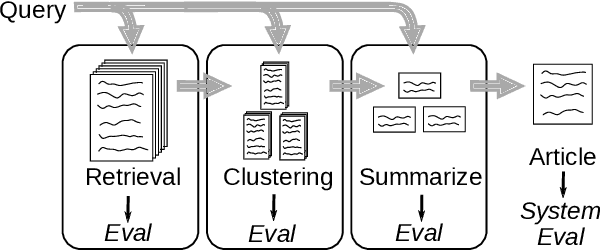


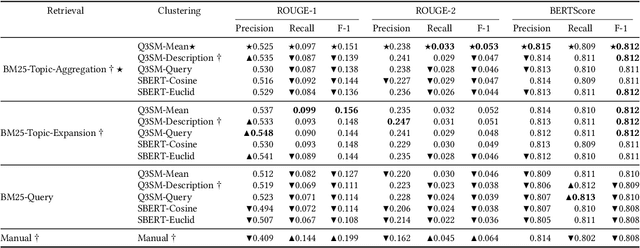
Abstract:Query-specific article generation is the task of, given a search query, generate a single article that gives an overview of the topic. We envision such articles as an alternative to presenting a ranking of search results. While generative Large Language Models (LLMs) like chatGPT also address this task, they are known to hallucinate new information, their models are secret, hard to analyze and control. Some generative LLMs provide supporting references, yet these are often unrelated to the generated content. As an alternative, we propose to study article generation systems that integrate document retrieval, query-specific clustering, and summarization. By design, such models can provide actual citations as provenance for their generated text. In particular, we contribute an evaluation framework that allows to separately trains and evaluate each of these three components before combining them into one system. We experimentally demonstrate that a system comprised of the best-performing individual components also obtains the best F-1 overall system quality.
Perspectives on Large Language Models for Relevance Judgment
Apr 13, 2023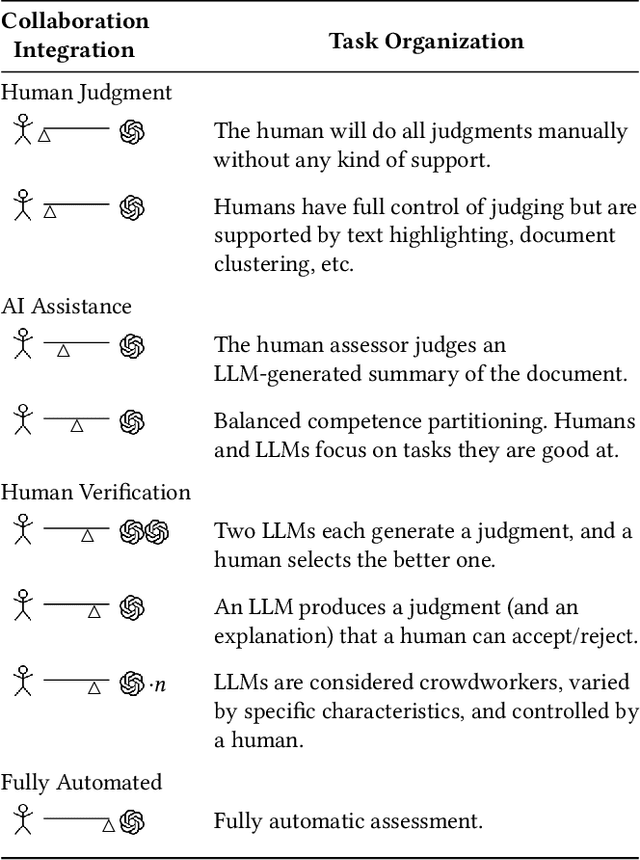
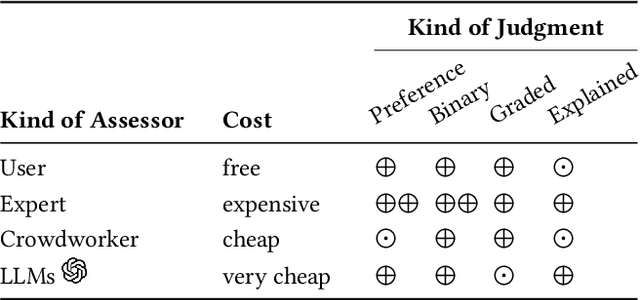
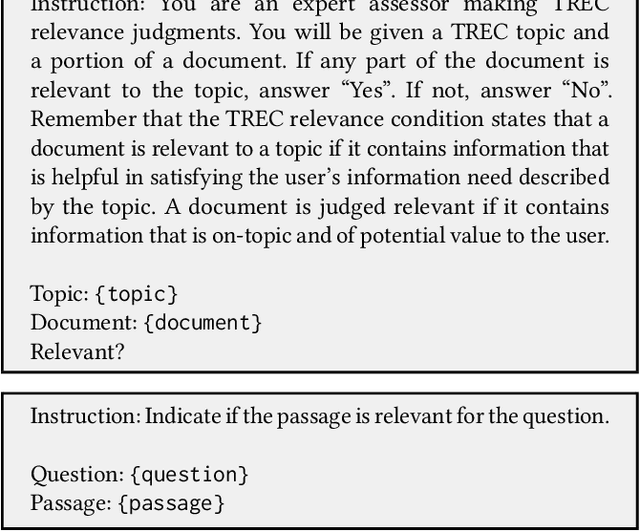
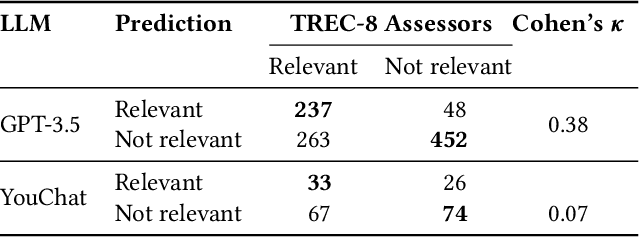
Abstract:When asked, current large language models (LLMs) like ChatGPT claim that they can assist us with relevance judgments. Many researchers think this would not lead to credible IR research. In this perspective paper, we discuss possible ways for LLMs to assist human experts along with concerns and issues that arise. We devise a human-machine collaboration spectrum that allows categorizing different relevance judgment strategies, based on how much the human relies on the machine. For the extreme point of "fully automated assessment", we further include a pilot experiment on whether LLM-based relevance judgments correlate with judgments from trained human assessors. We conclude the paper by providing two opposing perspectives - for and against the use of LLMs for automatic relevance judgments - and a compromise perspective, informed by our analyses of the literature, our preliminary experimental evidence, and our experience as IR researchers. We hope to start a constructive discussion within the community to avoid a stale-mate during review, where work is dammed if is uses LLMs for evaluation and dammed if it doesn't.
Knowledge-rich Image Gist Understanding Beyond Literal Meaning
Apr 18, 2019



Abstract:We investigate the problem of understanding the message (gist) conveyed by images and their captions as found, for instance, on websites or news articles. To this end, we propose a methodology to capture the meaning of image-caption pairs on the basis of large amounts of machine-readable knowledge that has previously been shown to be highly effective for text understanding. Our method identifies the connotation of objects beyond their denotation: where most approaches to image understanding focus on the denotation of objects, i.e., their literal meaning, our work addresses the identification of connotations, i.e., iconic meanings of objects, to understand the message of images. We view image understanding as the task of representing an image-caption pair on the basis of a wide-coverage vocabulary of concepts such as the one provided by Wikipedia, and cast gist detection as a concept-ranking problem with image-caption pairs as queries. To enable a thorough investigation of the problem of gist understanding, we produce a gold standard of over 300 image-caption pairs and over 8,000 gist annotations covering a wide variety of topics at different levels of abstraction. We use this dataset to experimentally benchmark the contribution of signals from heterogeneous sources, namely image and text. The best result with a Mean Average Precision (MAP) of 0.69 indicate that by combining both dimensions we are able to better understand the meaning of our image-caption pairs than when using language or vision information alone. We test the robustness of our gist detection approach when receiving automatically generated input, i.e., using automatically generated image tags or generated captions, and prove the feasibility of an end-to-end automated process.
 Add to Chrome
Add to Chrome Add to Firefox
Add to Firefox Add to Edge
Add to Edge